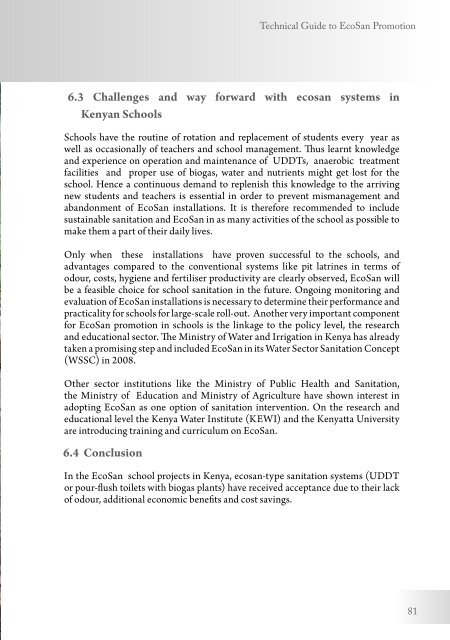Technical Guide to EcoSan Promotion
Technical Guide to EcoSan Promotion
Technical Guide to EcoSan Promotion
You also want an ePaper? Increase the reach of your titles
YUMPU automatically turns print PDFs into web optimized ePapers that Google loves.
<strong>Technical</strong> <strong>Guide</strong> <strong>to</strong> <strong>EcoSan</strong> <strong>Promotion</strong><br />
6.3 Challenges and way forward with ecosan systems in<br />
Kenyan Schools<br />
Schools have the routine of rotation and replacement of students every year as<br />
well as occasionally of teachers and school management. Thus learnt knowledge<br />
and experience on operation and maintenance of UDDTs, anaerobic treatment<br />
facilities and proper use of biogas, water and nutrients might get lost for the<br />
school. Hence a continuous demand <strong>to</strong> replenish this knowledge <strong>to</strong> the arriving<br />
new students and teachers is essential in order <strong>to</strong> prevent mismanagement and<br />
abandonment of <strong>EcoSan</strong> installations. It is therefore recommended <strong>to</strong> include<br />
sustainable sanitation and <strong>EcoSan</strong> in as many activities of the school as possible <strong>to</strong><br />
make them a part of their daily lives.<br />
Only when these installations have proven successful <strong>to</strong> the schools, and<br />
advantages compared <strong>to</strong> the conventional systems like pit latrines in terms of<br />
odour, costs, hygiene and fertiliser productivity are clearly observed, <strong>EcoSan</strong> will<br />
be a feasible choice for school sanitation in the future. Ongoing moni<strong>to</strong>ring and<br />
evaluation of <strong>EcoSan</strong> installations is necessary <strong>to</strong> determine their performance and<br />
practicality for schools for large-scale roll-out. Another very important component<br />
for <strong>EcoSan</strong> promotion in schools is the linkage <strong>to</strong> the policy level, the research<br />
and educational sec<strong>to</strong>r. The Ministry of Water and Irrigation in Kenya has already<br />
taken a promising step and included <strong>EcoSan</strong> in its Water Sec<strong>to</strong>r Sanitation Concept<br />
(WSSC) in 2008.<br />
Other sec<strong>to</strong>r institutions like the Ministry of Public Health and Sanitation,<br />
the Ministry of Education and Ministry of Agriculture have shown interest in<br />
adopting <strong>EcoSan</strong> as one option of sanitation intervention. On the research and<br />
educational level the Kenya Water Institute (KEWI) and the Kenyatta University<br />
are introducing training and curriculum on <strong>EcoSan</strong>.<br />
6.4 Conclusion<br />
In the <strong>EcoSan</strong> school projects in Kenya, ecosan-type sanitation systems (UDDT<br />
or pour-flush <strong>to</strong>ilets with biogas plants) have received acceptance due <strong>to</strong> their lack<br />
of odour, additional economic benefits and cost savings.<br />
81

















